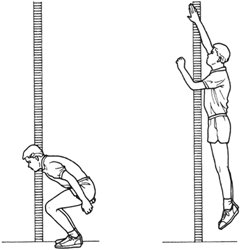Why is it used? I use it for the basis of lots of assessment- necessary if you are doing anything that involves power- and running, and a great way to see how reconditioned someone is to that activity! Try it on yourself….and look at the normal values below.
Like everything you need to use it as test and retest for a good objective reliable marker.
In practically all the world of sport the vertical leap can be and is frequently used as a measuring tool to assess the ability to display power, explosive strength, and the ability to use strength. Jumping ability is to athletic development what the ability to accelerate from 0-60 is to street-car racing. You can put a bigger engine in a car, but what it can do with the horsepower it has is evaluated in the race. Unless it can “get it up and go” quickly, that extra horsepower is of no use. In much the same way the vertical jump assesses your “get up and go” and how well horsepower can be used. It can be a quick and easy way to see reconditioning and lack of explosive power.
Vertical jump measurements are used primarily in athletic circles both to measure performance and as something athletes brag about among themselves. The most common sports in which one’s vertical jump is measured are athletics basket ball and football. In addition, single and multiple vertical jumps are occasionally used to assess muscular strength and anaerobic power in athletes.
Measuring vertical jump ability for leg power assessment is not necessarily a simple process. There are many jump techniques, measurement methods and equipment variations. All these can affect the results, reliability and interpretation of the test.
Squat Jump or Static Jump
In its simplest form, the vertical jump test is performed as a squat jump or static jump. In this technique, the subject starts from a stationary semi-squatting position, or pauses at the lower level of the squat before jumping upwards. This removes the factor of the stretch-shortening cycle (pre-stretching of muscles) and the jump result will be smaller than other techniques described below. The difference in jump height is typically 3-6 cm without a countermovement
Equipment used: A measuring tape or a Marked wall and chalk for marking the wall, special kit can be bought to help with the job.
Procedure: the athlete stands side on to a wall and reaches up with the hand closest to the wall. Keeping the feet flat on the ground, the point of the fingertips is marked or recorded. This is called the standing reach height. The athlete then stands away from the wall, and leaps vertically as high as possible using both arms and legs to assist in projecting the body upwards. The jumping technique can or cannot use a countermovement. Attempting to touch the wall at the highest point of the jump. The difference in distance between the standing reach height and the jump height is the score. The best of three attempts is recorded
Vertical Jump Norm Table
The table below categorizes the vertical jump height in centimeters and inches for adult men and women. The ratings are just for guidance, but can give you an idea of what to look for!
| males | females | |||
|---|---|---|---|---|
| rating | (inches) | (cm) | (inches) | (cm) |
| excellent | > 28 | > 70 | > 24 | > 60 |
| very good | 24 – 28 | 61-70 | 20 – 24 | 51-60 |
| above average | 20 – 24 | 51-60 | 16 – 20 | 41-50 |
| average | 16 – 20 | 41-50 | 12 – 16 | 31-40 |
| below average | 12 – 16 | 31-40 | 8 – 12 | 21-30 |
| poor | 8 – 12 | 21-30 | 4 – 8 | 11-20 |
| very poor | < 8 | < 21 | < 4 | < 11 |
Just for your interest Michael Jordan’s Vertical jump height is 122cm!
Best get practicing!

